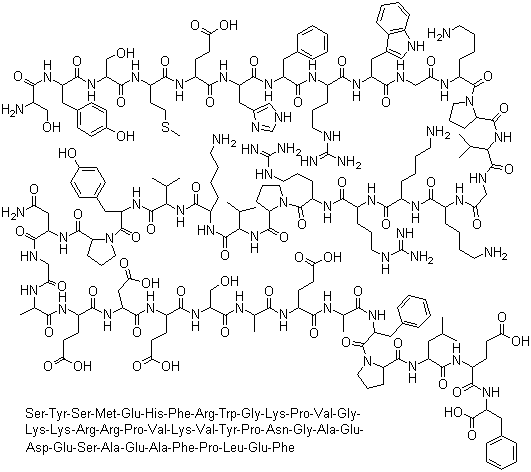
1317-80-2
- Product Name:Titanium oxide
- Molecular Formula:O2Ti
- Purity:99%
- Molecular Weight:79.86
Product Details;
CasNo: 1317-80-2
Molecular Formula: O2Ti
Appearance: White powder.
Chinese Factory Supply High Purity Titanium oxide 1317-80-2 with Safe Transportation
- Molecular Formula:O2Ti
- Molecular Weight:79.86
- Appearance/Colour:White powder.
- Melting Point:1840 °C
- Boiling Point:2500ºC
- Flash Point:2500-3000ºC
- PSA:0.00000
- Density:4.26 g/mL at 25 °C(lit.)
- LogP:-0.23760
Titanium oxide(Cas 1317-80-2) Usage
|
General description |
Titanium dioxide is naturally presented in titanium ore and rutile titanium. Its molecular structure makes it contain high luminance and covering property. But it must be subject to first extraction and purification. 60 years ago, the DuPont Company had developed the chlorination process as the production technology of titanium dioxide. Because of its relative old sulfuric acid process, it is capable of manufacturing high-quality paint products while reducing environmental emissions and energy consumption and therefore has become the preferred technique in the world. Titanium dioxide (or TiO2) is the most widely used white pigment in the field of industry, being used in architecture, industry and automotive coatings; furniture, electrical appliances, plastic tape and plastic box-purpose plastic; high-grade magazines, publicity pictures and paper for attached film as well as specialty product such as ink, rubber, leather and elastomers. |
|
Chemical Properties |
Rutile is one of the major minerals containing titanium. It is tetragonal and often has intact tetra-columnar or needle crystalline-like structure. Its aggregate exhibits granular or compacting blocky shape. It appears as dark, red, maroon, yellow or orange color with iron-rich product appearing as black color; it streaks appears as yellow to light brown color. It has adamantine gloss. Iron rutile exhibits semi-metallic gloss. It is brittle with the hardness being 6 to 6.5 and the density being 4.2~4.3 g/cm3. Products being rich in iron, niobium and tantalum have the density being increased with the high value being up to 5.5 g/cm3 or more. It can be dissolved in hot phosphoric acid. After cooling and dilution, adding sodium peroxide can turn the solution to brown color (titanium reaction). Rutile can be produced in gneiss, pegmatite, eclogite (flash) rock and placer. |
|
Uses |
It can be used for the production of titanium dioxide, titanium sponge, titanium alloys, synthetic rutile, titanium tetrachloride, titanyl sulfate, potassium hexafluorotitanate and aluminum chloride or titanium chloride. Titanium dioxide can be used for making high-grade white paint, white rubber, synthetic fibers, paint, welding electrodes and the light reducing agent of rayon as well as the filler of plastics and advanced paper. It can also be applied to telecommunications equipment, metallurgy, printing, dyeing, enamel and other departments. Rutile is also the main mineral raw materials for extraction of titanium. Titanium and its alloys have many excellent properties including high strength, low density, excellent anti-corrosion properties, high temperature resistance, low temperature resistance and non-toxicity; it also has special features such as absorbing gases and superconductivity, and therefore is widely used in various kinds of fields including aviation, chemicals, light industry, navigation, medical, defense and marine resources development and so on. According to reports, more than 90% of the titanium mineral in the world has been used the production of titanium dioxide white pigment, and this product has more and more wide application in the paint, rubber, plastics, paper and some other industries. It can be used for welding, refining of titanium and manufacturing of titanium dioxide. It can be used as reagents analysis as well as being used for the preparation of highly pure titanium salts and being applied to pharmaceutical industry. It can be used as the carrier of catalyst, photo-catalytic media and the protection media against UV radiation. It also has wide application in various kinds of filed such as the coatings, plastics, self-cleaning automotive glass, automotive mirrors, act wall glass, screen glass bulb, air purification materials, medicine, cosmetics, water treatment, tanning and ink and so on. |
|
Production method |
It is mostly from strip mining. The selection of ore for the primary deposit of Titanium can be divided into three stages including pre-selection (usual through magnetic separation and gravity separation), iron selection (using magnetic separation) and Titanium selection (gravity separation, magnetic separation, electrostatic separation and flotation); The ore selection of Ti-Zr sand mineral (mainly include beach placer, followed by inland placer) mineral processing can be divided into two steps including roughing selection and featured. In 1995, the mining department in Zhengzhou Institute of comprehensive utilization had applied magnetic separation-gravity selection-acid leaching process for ore selection on the large-scale rutile ore in Xixia of Henan Province and had already passed the trial production with various kinds of indicators reaching the domestic leading level. |
|
Definition |
Rutile: A naturally occurring reddish-brown form of titanium(IV) oxide, TiO4. It is an ore of titanium and is also used in making ceramics. Some clear varieties of rutile are used as a semiprecious gemstone. |
|
Brand name |
Tinosorb M (Ciba Specialty Chemicals). |
InChI:InChI=1/2O.Ti/rO2Ti/c1-3-2
Relevant Products
-
Corticotropin
CAS:9002-60-2
-
polypropylene
CAS:9003-07-0
-
Humic acid sodium salt
CAS:68131-04-4







